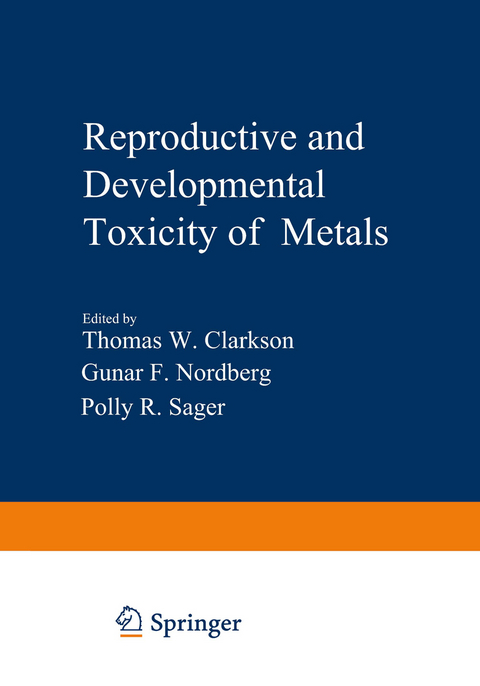
Reproductive and Developmental Toxicity of Metals
Springer-Verlag New York Inc.
978-1-4615-9348-5 (ISBN)
An Overview of the Reproductive and Developmental Toxicity of Metals.- Review Articles.- Effects of Metals on Male Reproduction.- Reproductive and Developmental Toxicity of Metals: Female Reproductive System.- The Congenital Teratogenicity and Perinatal Toxicity of Metals.- Effects of Metals: The Developing Central Nervous System.- Prenatal Metabolism: Metals and Metallothionein.- Effects and Metabolism of Toxic Trace Metals in the Neonatal Period.- Invited Papers.- Session 1. Effects of Metals on the Male Reproductive System.- Normal Testicular Structure and Methods of Evaluation under Experimental and Disruptive Conditions.- Effects of Environmental Metals on Male Reproduction.- Effects of Occupational Exposure to Lead on Sperm and Semen.- Cadmium and Reproduction: A Perspective After 25 Years.- Session 2. Effects of Metals on the Female Reproductive System.- Ovarian Toxicity: Effects on Sexual Maturation, Reproduction and Menopause.- Lead and Development of the Early Embryo.- Effect of Lead on Reproductive Capacity and Development of Mammals.- Spontaneous Abortion as Risk Indicator in Metal Exposure.- Session 3. Birth Defects and Perinatal Toxicity.- Metal-Induced Congenital Malformations.- Embryotoxicity and Teratogenicity of Nickel Compounds.- The Influence of Weight and Other Physiological Changes During Pregnancy and Lactation on the Toxicities of Mercury and Cadmium.- Ultrastructural and Biochemical Alterations of Cellular Organelles by Prenatal Exposure to Toxic Trace Metals.- Session 4. The Developing Central Nervous System.- Critical Processes in CNS Development and the Pathogenesis of Early Injuries.- Effects of Prenatal Methylmercury Poisoning upon Growth and Development of Fetal Central Nervous System.- Neurobehavioral Consequences of Early Exposure to Lead in Rhesus Monkeys: Effects on Cognitive Behaviors.- Central Nervous Effects of Perinatal Exposure to Lead or Methylmercury in the Monkey.- Developmental Toxicity of Metals: Implications for Public Health.- Session 5. Prenatal Aspects of the Metabolism of Metals.- The Placenta: Relevance to Toxicology.- Disposition of Metals in the Embryo and Fetus.- Heavy Metal Alterations of Placental Function: A Mechanism for the Induction of Fetal Toxicity in Cadmium.- Endogenous Metal-Binding Proteins in the Control of Zinc, Copper, Cadmium and Mercury Metabolism during Prenatal and Post-natal Development.- The Cellular Accumulation and Subcellular Localization of Metallothionein in Rat Liver during Postnatal Development.- Methylmercury Metabolism in Pregnant Mice: Its Modification by Selenium with Particular Reference to Prenatal Toxicity of These Compounds.- Session 6. Postnatal Aspects of the Metabolism of Metals.- Specific Features of Metal Absorption in Suckling Animals.- Are Developmental Changes in Methylmercury Metabolism and Excretion Mediated by the Intestinal Microflora?.- Trace Element Absorption in Infants: Potentials and Limitations.- Differences in Exposure and Metabolic Response of Infants and Adults to Lead, Cadmium and Zinc.- Special Topic Papers.- The International Programme on Chemical Safety in Relation to Reproductive and Developmental Toxicology.- Quality Control in Laboratories Testing for Environmental Pollution.- Participants.- Author Index.
| Zusatzinfo | XVIII, 846 p. |
|---|---|
| Verlagsort | New York, NY |
| Sprache | englisch |
| Maße | 170 x 244 mm |
| Themenwelt | Studium ► 2. Studienabschnitt (Klinik) ► Pharmakologie / Toxikologie |
| Veterinärmedizin | |
| ISBN-10 | 1-4615-9348-4 / 1461593484 |
| ISBN-13 | 978-1-4615-9348-5 / 9781461593485 |
| Zustand | Neuware |
| Haben Sie eine Frage zum Produkt? |
aus dem Bereich


